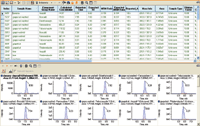Using the iDQuant™ Standards Kit for Pesticide Analysis to Analyze Residues in Fruits and Vegetable Samples
The iDQuant? Standards Kit for pesticide analysis of certified reference material (ISP Guide 34, IOS/IEC 17025, and ISO 9001:2008) includes 204 pesticides in 10 mixes at a concentration of 100 ?g/mL. This kit has been designed to eliminate the need to source pesticides individually, and measure each one manually. This allows users to setup, verify, and validate the performance of pesticide screening methods faster.
The iDQuant™ Standards Kit for pesticide analysis of certified reference material (ISP Guide 34, IOS/IEC 17025, and ISO 9001:2008) includes 204 pesticides in 10 mixes at a concentration of 100 μg/mL. This kit has been designed to eliminate the need to source pesticides individually, and measure each one manually. This allows users to setup, verify, and validate the performance of pesticide screening methods faster.
Many recent developments such as generic extraction procedures, (like QuEChERS), generic LC separation methods, and highly selective and sensitive MS-MS detectors have established LC–MS-MS as a standard technique for the analysis of pesticide residues in food. Hundreds of targeted analytes can be detected in a single analytical run. Software designed for ease-of-use like Cliquid® software in conjunction with iMethod™ applications made the fast adaptation of LC–MS-MS in new routine testing laboratories possible. For a while, data processing was the bottleneck for most laboratories, but the development of fast and automatic data processing and reporting tools sped up the delivery of analytical results.
A major hurdle for each laboratory is method setup, verification, and validation. The newly available iDQuant™ kit can be used for the following tasks:
- Tune or verify MRM transitions for best selectivity and sensitivity of MS-MS detection
- Measure retention times to quickly update acquisition methods using the Scheduled MRM™ algorithm
- Investigate recovery and reproducibility of sample preparation procedures
- Validate the performance of the complete method procedure
Experimental
The iDQuant™ standards kit was used for method setup and preparation of calibration standards. Fruits and vegetables were extracted using a QuEChERS procedure and diluted 10× with water to optimize chromatographic peak shape and minimize possible matrix effects. LC separation was achieved on a Shimadzu UFLCXR system with a Restek Ultra Aqueous C18 3 μm (100 × 2.1 mm) column and a 15 min gradient of water and methanol with ammonium formate buffer at a flow rate of 0.5 mL/min. The AB Sciex QTRAP® 5500 system was operated with Electrospray Ionization. 436 MRM transitions were monitored using the Scheduled MRM™ algorithm.
Results
The developed LC–MS-MS method was successfully applied to detect pesticides in food samples. Chromatograms were processed using the "multicomponent" query in MultiQuant™ software to automatically report concentrations above the threshold of 10 μg/kg and to compare MRM ratios for compound identification (Figure 1).

Figure 1: Pesticides above 10 μg/kg and with a positive identification based on their MRM ratio following guideline SANCO/10684/2009.
Summary
The iDQuant™ Standards Kit for pesticide analysis was used to successfully setup an LC–MS-MS method to identify and quantify pesticides in fruit and vegetable samples. This was accomplished in less time than it was previously possible when a standard kit was either unavailable or had to be created from individual standards.
© 2011 AB Sciex. The trademarks mentioned herein are the property of AB Sciex Pte. Ltd. or their respective owners. AB Sciex™ is being used under license.
AB Sciex
110 Marsh Drive, Foster City, CA 94404
tel. (877) 740-2129, fax (650) 627-2803
Website: www.absciex.com

Analytical Challenges in Measuring Migration from Food Contact Materials
November 2nd 2015Food contact materials contain low molecular weight additives and processing aids which can migrate into foods leading to trace levels of contamination. Food safety is ensured through regulations, comprising compositional controls and migration limits, which present a significant analytical challenge to the food industry to ensure compliance and demonstrate due diligence. Of the various analytical approaches, LC-MS/MS has proved to be an essential tool in monitoring migration of target compounds into foods, and more sophisticated approaches such as LC-high resolution MS (Orbitrap) are being increasingly used for untargeted analysis to monitor non-intentionally added substances. This podcast will provide an overview to this area, illustrated with various applications showing current approaches being employed.

















